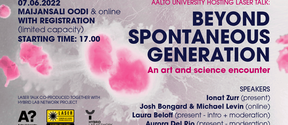LASER Talks: Adaptation and Bodies in Context
In what ways are we (humans) as a species able to adapt to the changes in our habitat and environment? And what does that imply?

Aalto University joined the list of LASER Talks hosts in 2020, and the January event will be the first-ever held in Finland.
LASER Talks (Leonardo Art Science Evening Rendezvous, LASER) are an initiative launched by Leonardo/The International Society for the Arts, Sciences and Technology (Leonardo/ISAST), a nonprofit organization that serves the global network of distinguished scholars, artists, scientists, researchers and thinkers through their programs, which focus on interdisciplinary work, creative output and innovation. Aalto community is able to access Leonardo Journal publications within Aalto network or via VPN connection.
This gathering will bring artists, scientists, humanists and technologists, working across disciplines in Finland and internationally, together for informal presentations and conversations with the wider public.
The event is open for the Aalto community members and wider public, with a registration. More detailed information about the speakers and the registration link will be published in the beginning of January on the event page.
During COVID-19, we will convene online, and the programme of the future talks will be announced in 2021. The aim is to organise 2-4 LASER Talks every year.
If you are interested in giving a LASER Talk at Aalto, please send an abstract to [email protected]i.
LASER Talks series at Aalto University is organised by:
The mission of LASER is to encourage contribution to the cultural environment of a region by fostering interdisciplinary dialogue and opportunities for community building to over 40 cities worldwide.

In what ways are we (humans) as a species able to adapt to the changes in our habitat and environment? And what does that imply?

Under the theme ‘Adaptation and Space’ this LASER Talk at Aalto University will intersect different practices and discourses as heterogeneous but complementary articulations of ‘space’, that address, operate on and contribute, in different ways and capacities, to the transformation of the contemporary environment and its challenges: the social, the infrastructural, the technological, the sensory, the virtual, the built and the unbuilt.

What if the evolution chain, once pictured as a line, was instead a circle, now caught at the moment when reaching its point of origin?



